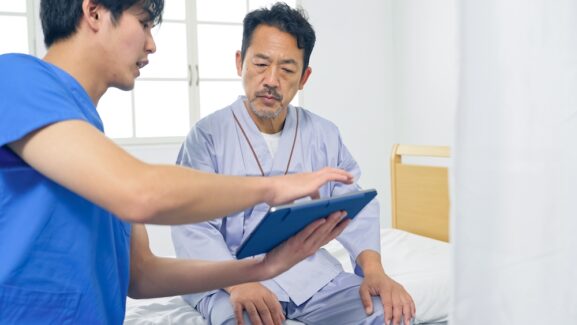Study Finds Ketamine Telehealth Is A Safe And Effective Treatment For Anxiety And Depression
A study published in the Journal of Affective Disorders has concluded that at-home, sublingual ketamine telehealth is a safe and effective treatment for moderate to severe anxiety and depression.
RELATED: How The Brain Changes In People With Chronic PTSD Following Ketamine Treatment
The Rise Of Ketamine Telehealth
Ketamine telehealth clinics (or online ketamine clinics) are on the rise. KetaMD was one such company that emerged from the pandemic, the first — in fact — to offer ketamine prescriptions over video calls. These clinics offer sublingual ketamine, so the drug comes in the form of tablets placed under the tongue and then left there to dissolve.
This new study acknowledges that at-home ketamine-assisted therapy, using remote monitoring through telehealth platforms, addresses barriers to access, including the COVID-19 pandemic.
This service is no doubt very convenient, as well as more affordable than in-person treatment. However, researchers wanted to look at whether this form of ketamine-assisted therapy was safe and effective in the treatment of anxiety and depression.
RELATED: Where is Ketamine Telehealth Legal?
The Setup Of The Study
A large outpatient sample (1,247 patients) received ketamine-assisted therapy over four weeks through a telehealth provider (Mindbloom). The platform is accessible through an internet search or external physician/provider referral. Patients first had to complete an eligibility questionnaire and, if eligible, would then undergo a medical and psychiatric evaluation.
Patient records totaling 2,848 were reviewed with exclusion criteria in mind, which included certain health conditions, alcohol or drug addiction, and particular psychological risk factors (psychotic or manic symptoms and active suicidal ideation). Of these 2,848 people, 28 dropped out prior to the first ketamine session. 1,247 remained who could provide sufficient data for analysis.
Patients who met the eligibility criteria were sent a single 300-450 mg dose of sublingual, rapidly dissolving ketamine tablet to determine ongoing dosage. Ondansetron (a medication for nausea) and materials for the safe and proper administration of the ketamine (a digital blood pressure cuff, a journal, an eye mask, and instructions) were mailed as well.
To prepare for treatment, patients logged in to their web portal to review written and video materials. Each patient was also paired with a specially trained “guide” who was available for as-needed support by text message throughout treatment. Prior to the first medication session, patients met with their guide for a 30-minute video call to help establish a positive set and setting (or mindset and environment).
RELATED: Ketamine Telehealth vs In-Clinic Ketamine Therapy
Guides also ensured the patient was using the blood pressure cuff properly and that blood pressure and heart rate were in a safe range. Patients were also required to abstain from food for three hours, fluids for one hour, and alcohol, stimulants, and benzodiazepines on the day of treatment.
During the medication session, patients held the ketamine tablet under their tongue or between the cheek and gums, without swallowing, for seven minutes, at which time they spit out all the saliva. Patients then lay down, put on their eye masks and headphones, and listened to the music provided.
After the sessions, the patients journaled and then had a video call with their guide. They later met with the prescribing clinician by video to describe their reaction. Integration sessions with the guide were held after the second session and then again after the fourth and final session. These were opportunities for patients to try to make sense of their experiences and apply them to their everyday lives.
The guides were not licensed professionals and did not provide psychotherapy, but they did offer active listening and warm and empathetic responses to the patients.
Researchers in the study analyzed mental health outcomes by using the 9-item Patient Health Questionnaire (which measures symptoms of major depression) and the 7-item Generalized Anxiety Disorder questionnaire.
The researchers also assessed side effects and adverse events through a self-report measure after the second and fourth sessions. Patients were asked “Have you noticed any issues with your physical or mental health since beginning treatment?” They had a number of response options to choose from.
RELATED: Here’s Why Ketamine Is Different Than Any Other Psychedelic
Positive Results And A Small Number Of Adverse Events
The study found rapid, significant, and persisting improvements in symptoms for 62.8 percent of depressed patients and 62.9 percent of anxious patients. Moreover, after the last ketamine session, 32.6 percent of depressed patients achieved remission, while for anxiety patients the figure was 31.3 percent.
The researchers noted that these rates are “consistent with laboratory- and clinic-administered ketamine treatment.”
Side effects were reported by 59 (4.7 percent) patients after the second session and by 27 (3.8 percent) patients after the fourth. Four of these individuals discontinued treatment due to adverse events:
“one due to elevated heart rate, one due to worsening symptoms of depression, one needing to visit a urologist for follow-up on increased urinary pressure, including hematuria [the presence of blood in the urine] 24 hours after the fourth medication session, which resolved with confirmatory CT and ultrasound, and a final who presented to the ER for worsening anxiety and depression who was then admitted for ongoing psychiatric services.”
Nonetheless, with less than one percent of patients deteriorating, and a small number of people discontinuing the treatment due to adverse events, the authors conclude that “this form of ketamine treatment has an exceedingly desirable safety profile.”
RELATED: How Ketamine Treatment For Anxiety Works, Per Medical Experts




Colleen M Omara
July 28, 2022 at 6:14 amGreat arrival thanks!!